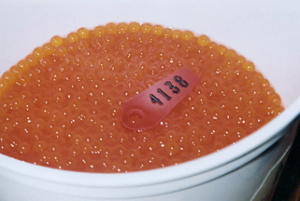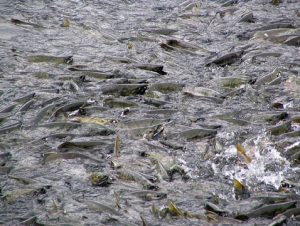QUESTION: Should I eat farmed or wild salmon? I know that farmed salmon may not be as healthy, and fish farms tend to be environmentally damaging. However, many wild runs of salmon are on the brink and I do not want to contribute to their demise. Asked by Amy Fowler, San Jose, Calif.
ANSWER: For being the same animal, farmed salmon and wild salmon are drastically different. They present different levels of health risk and environmental impact, and they even taste different to avid salmon connoisseurs. But which should we eat?

Salmon, found in both the Northern Atlantic and Northern Pacific oceans, once spawned in rivers in North America, Asia and Europe. However, damming up rivers and cutting down nearby forests has distressed—and even eliminated—many salmon runs. Heavy fishing hasn’t helped either. As the number of wild salmon decreased, more fish farms started popping up to meet the increasing consumer demand for salmon. Farmed fish, the Atlantic species of salmon, are raised in net cages in calm areas near the shore. The farms supply cheap salmon year round, while wild salmon supplies are much more seasonal.
More than 10 years ago, a study estimated that 94 percent of all Atlantic salmon came from fish farms—there simply aren’t very many left in the wild. Though wild Pacific salmon are in better shape than Atlantic, natural salmon runs are not sufficient to meet demand for the fish. In 1980, farmed Pacific salmon made up around 1 percent of the market. In 2003, more than 60 percent of the Pacific salmon in the market came from fish farms, and this number continues to rise.
You could argue that by eating farmed salmon, you’re not eating wild fish and not hurting these already stressed populations. Unfortunately, this just isn’t true. Salmon eat other fish, so the feed given to farmed salmon is largely composed of ground-up, wild fish. This depleted the availability of food for wild salmon.
One study has shown that the world’s fisheries as a whole have declined since the increase in farming. Additionally, the nets made to contain farmed salmon occasionally fail, and fish escape. Once in the wild, farmed salmon are less likely to survive early stages of life. However, they grow faster; if they survive youth, they outcompete native fish later in life. The farmed salmon can also spread disease to the wild. In the Atlantic, breeding between farmed and wild fish could lead to an overall decrease in the fitness of the fish.

Farmed salmon also contain more toxins than their wild counterparts since their feed contains higher toxin levels. The uneaten food, antibiotics, pesticides and feces of the fish pollute the water with both nutrients and chemicals.
That all being said, if everyone decides to eat wild salmon all the time, the natural fishery will collapse. So if salmon is a dish you don’t have very often, treat yourself to the wild variety, preferably Alaskan salmon, where the runs are still healthy and well managed. However, if you eat salmon often, perhaps you should look into alternatives. The Monterey Bay Aquarium publishes the Seafood Watch, which lets you know which fish are caught (or farmed) in environmentally friendly ways and which fish contain significant levels of toxins. They recommend Arctic char as a good alternative to salmon. Whether you’re moved by saving the environment or keeping yourself healthy, farmed salmon are not the best fish to eat.


The article reads:
“Salmon eat other fish, so the feed given to farmed salmon is largely composed of ground-up, wild fish. This depleted the availability of food for wild salmon.”
Now, wait a minute. The obvious implication here is that any fishing at all in areas of the ocean where wild salmon live is bad, because it wild salmon could conceivably have eaten whatever fish that are caught.
There should be a moratorium on all commercial fishing in entire zones of the ocean for the sake of a single type of fish whose populations have dwindled? That’s just plain silly.
I’ve heard a number of bogus arguments against the idea of eating farmed salmon. One of them was the insistence that some of the food pellets fed to the farmed fish drift out through the nets and are eaten by other fish, resulting in their “overfeeding.” Whoever came up with that was apparently extrapolating from their goldfish.
Another silly argument I’ve heard is that some of those “escaped” food pellets are eaten by wild salmon, fattening them to the point where they’re unable to swim upstream as far as other salmon in order to spawn.
First of all, even if that were true, bigger-than-normal salmon would obviously pair off with others of like size in whatever depth of water they could reach.
Secondly, I’ve hiked in the Aleutian islands and walked along streams in which there were spawning salmon. Those big fish had absolutely no problem swimming into water that was a fraction as deep as their bodies were.
What underlies this sort of nonsense is the knee-jerk assumption that any effect man has on the natural environment is necessarily harmful.
Pingback: Study finds fewer Americans concerned about climate change in 2010 than in 2008 | Change 2010